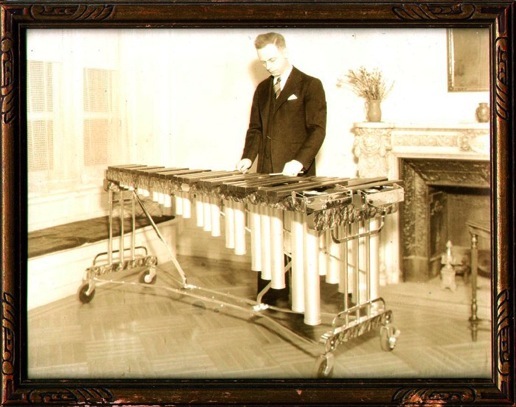George Hamilton Green Tips to the Xylophonist
Rules for Practice
(from Introduction of the Method “Instruction Course")
1) Place your music stand directly in front of the center of the instrument and adjust the stand so the music in about two inches above the keyboard.
-
2)When practicing keep the hand low. When playing the little finger of each hand should almost touch the keyboard.
-
3)Always strike with the wrist. Do not attempt to strike with an arm movement. when raising a hammer to strike a note, use wrist action only. The forearm should not move.
-
4)Always keep the hammers low. This is absolutely necessary in order to obtain speed. When striking a note, do not raise the hammers any higher than necessary. The lower you keep the hammers the better. Remember, it takes more time to raise the hammers six inches and bring them back, than it does to raise them only three inches.
-
5)Always keep a steady tempo. This is very important.
-
6)Always give each note and each measure the proper amount of time value. For example, if you have one measure in 4/4 time containing eight notes, and the following measure containing a whole note, both measures should receive exactly the same count, or same amount of time. Many pupils, in their anxiety to play fast, form a habit of not giving the sustained notes the proper amount of time. This is a mistake which must be avoided.
-
7)When practicing, bear in mind that every note must be struck correctly. I realize that nearly every Xylophonist has a desire to play fast. However, it is positively a waste of time to attempt to play fast at the expense of striking wrong notes. The secret of fast, accurate playing is nothing else than a thorough knowledge of the keyboard. So first of all, gain a complete knowledge of the instrument by striking every note correctly, at a tempo slow enough to permit you to do so. Then as you become better acquainted with whatever you may be playing, you will be able to gradually increase the tempo and still strike each note correctly.
-
8)Your success as a player lies in your ability to practice. To obtain results you must practice and the more you practice, the quicker the results. “Practice makes perfect” is an old cliche, but it is well to bear it in mind all times. To develop good practice habits, decide on just how much time you can set aside for practice each day and, if possible, select the same hours each day. If you practiced two hours in the morning and one in the afternoon, this would be an excellent routine to follow, providing you did it every day. If you are engaged during the day at other vocation than music, two hours practice each evening and one-half hour each morning before business hours would be fine. The main idea is to devote all the time possible to steady practice, and form a habit of doing the same amount each day and do not let anything interfere with your practice. I have always advised pupils to practice a minimum of two hours. Form a routine and you will gain the quickest results.
-
9)The row of bars containing the sharps and flats on the xylophone should be raised above the row of bars containing the naturals. You will be able to play faster and more accurately, because it brings the sharps and flats closer to you, and you do not have to reach for them. When striking the bars containing the sharps and flats, always strike them on the extreme end of the bar nearest you. This will enable you to develop greater speed and accuracy. You will find that the tone is just as clear at the end of bar as in the middle. When sustaining a note with a roll, put one hammer on the middle of the bar and the other hammer on the end of the bar. I followed this system in all of my playing, including my work on phonograph records. If striking the bars on the end gave an inferior tone, it surely would show up on the records.
-
10) Do not devote all of your study to popular or jazz at the expense of sacrificing the technical studies. Remember, in order to play good popular or jazz music, it is necessary to have a thorough knowledge of the instrument, and this can be obtained only through good legitimate exercises and studies.
-
11) Develop proper hammering. If some marked out hammering seems awkward to you, do not change it, as it is written for the purpose of developing perfect technique in both hands.
-
12) Regarding the hammers you should use in all work. I advise the length of the hammers be thirteen inches, with one inch ball. The handle of the hammer should be fairly stiff, in order to give more accuracy. The one inch ball on the end should not be too hard. Avoid wooden or extremely hard rubber balls, as they not only ruin the instrument by pounding it full of dents, but the tone they produce is harsh and displeasing to the ear. I advise a three-quarter hard ball of rubber for all public renditions, and a half-hard ball or softer for practice. Select hammers that have good balance. They should not be too heavy or clumsy.
George Hamilton Green
